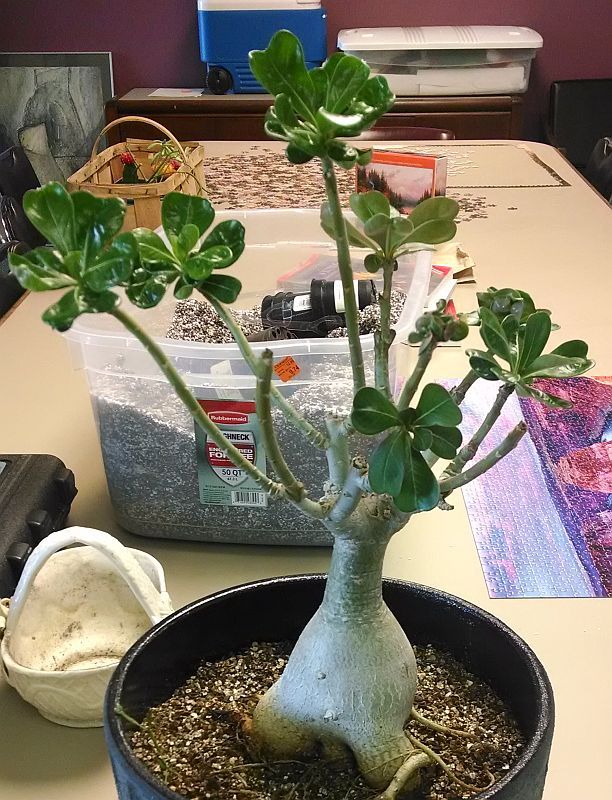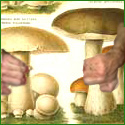|
What type of plants are you interested in growing? This poll is closed. |
|||
|---|---|---|---|
| Perennials! |
|
142 | 20.91% |
| Annuals! |
|
30 | 4.42% |
| Woody plants! |
|
62 | 9.13% |
| Succulent plants! |
|
171 | 25.18% |
| Tropical plants! |
|
60 | 8.84% |
| Non-vascular plants are the best! |
|
31 | 4.57% |
| Screw you, I'd rather eat them! |
|
183 | 26.95% |
| Total: | 679 votes | ||
|
Not sure anybody cares, but every single one of my grafts on my adenium took, meaning a tree with much better branching and form in the future. This presents an opportunity for anybody with a desert rose to much more easily control the look of their plant than was previously considered possible, when the only accepted way to induce more branching was to trim the plant. Here is a healed graft union:  And the tree as a whole:  Over the next year or so, the graft unions should heal up, making them nearly invisible, and the next time the tree goes dormant, I'll have a good pallet for trimming/possibly more grafting.
|
|
|
|

|
| # ? May 16, 2024 10:17 |
|
stubblyhead posted:I bought a new house recently, and the previous owner (now deceased) was an avid gardener. Every couple weeks something new starts sprouting or blooming, and lots of it we have no idea what they are. Can anyone identify this flower? That's a Centaurea montana, aka mountain bluet or perennial bachelor button. What most people call bachelor button/cornflower is the Centaurea cyanus.
|
|
|
|
After looking at some pictures it definitely is mountain cornflower. All my life I thought that maize corn had blue flowers. Thanks a lot, Crayola!
|
|
|
|
I have a little apple tree I bought a couple years ago and planted in the yard. Unfortunately last year when I hired my neighbor to remove a tree that was against the house, he or one of his workers accidentally lopped off the sapling (which would have looked like just a dead stick, and it's my fault for not pointing it out to them). Now it's re-sprouting and it's sent up a bunch of shoots! Hooray! However, it looks like most or all of the shoots are coming up from below the graft. So my question is, what is likely to happen if all I can get to grow are those below-graft shoots? Will I have a sterile non-fruiting tree or something? Is there something I can do to stimulate growth on the graft? I'm not certain the above-graft part is totally dead, but it might be. If this tree is basically not going to make me apples, I might as well just replace it, but I thought I'd ask first.
|
|
|
|
Select one of the shoots. Remove the others. Find somebody with an apple variety you actually want, and then you're going to want to chip-bud that variety onto your rootstock. Chip budding is a very small graft, so it'll be okay if you mess it up, but it's pretty easy to do it right if you just take your time. Fruits tend to graft pretty easily. There's half a million videos on youtube of how to chip bud.
|
|
|
|
That sounds like more effort than just buying another $30 apple tree sapling with the exact variety I want, but it's an interesting technique to maybe try out at some point.
|
|
|
|
Apple rootstock isn't selected for it's fruit quality, so yeah, either graft something as a fun experiment or replace with a new grafted tree. If you are going to dig it up you might want to take a look at this system: http://www.davewilson.com/home-gardens/backyard-orchard-culture Basically you plant 2 or more trees close together, head them back so the scaffold branches are much lower and do summer pruning instead of winter to keep the height down for easier maintenance.
|
|
|
|
If you want to just buy another apple, use it to get your bud for grafting onto your original! Seriously, fruit grafting is easy - just try it.
|
|
|
unprofessional posted:Not sure anybody cares, but every single one of my grafts on my adenium took, meaning a tree with much better branching and form in the future. This presents an opportunity for anybody with a desert rose to much more easily control the look of their plant than was previously considered possible, when the only accepted way to induce more branching was to trim the plant. You are a grafting machine. That's pretty cool, really! Looks like your Adenium didn't get too upset by the whole ordeal.
|
|
|
|
|
unprofessional posted:Not sure anybody cares, but every single one of my grafts on my adenium took, meaning a tree with much better branching and form in the future. This presents an opportunity for anybody with a desert rose to much more easily control the look of their plant than was previously considered possible, when the only accepted way to induce more branching was to trim the plant. That's cool as hell. It's not something I'd have thought of doing with any of my plants. Gonna bring some southern-hemisphere into this thread:  I transplanted this hebe, and I'm amazed that it took and then bloomed profusely at the start of summer. It inspired me to plant another hebe nearby, a variegated one. You see that nasturtium in the upper left corner? They snaked in through the neighbours' fence, and little did I know that they'd been making GBS threads seeds all over my garden all summer. I've pulled out hundreds of nasturtium seedlings and I'm still yanking them out    Corymbia ficifolia, a species of smaller eucalyptus tree. Blooms in late summer. There were tons of birds all over it, including this cute little fella.  Dwarf banksia. Banksias have these neat flower cones that last for months.  Tree fern time! I got this one from a Tasmanian native nursery. It has a double trunk! It's only small right now but I look forward to growing old together, me and this fern. Question:  What is this mystery plant? I grew up in a desert climate, so I had no idea what any of the temperate cottage-garden plants were that the previous owners had planted. (Seriously, I couldn't have identified a camellia until this year.) Holden Rodeo fucked around with this message at 07:46 on Apr 29, 2014 |
|
|
|
Looks like some sort of begonia. 
|
|
|
|
So, I was at Wal-Mart today, and they had some mostly post-bloom easter lilies that they were selling for about $1.50, and I got one of them. They were, uh, all pretty badly waterlogged from being outside in the recent rain (and the pots were wrapped in plastic so that filled up), so I've got the pot on top of a bowl with marbles at the base. I'm hoping the excess will drain out uneventfully and no permanent damage has happened to the bulb... I'm planning on eventually planting the lily in my front garden, but from what I understand that might be a bit of a problem since the bulb was probably forced so that it'd bloom in the spring? Is there anything I should do that could help ease the transition? Also, I only just noticed this when I got home, but a lot of the leaves have these small white splotches on them. They don't seem like eggs or bugs or anything like that. Is that abnormal? I don't have access to a camera today, but I could try to get some pics maybe by tomorrow?
|
|
|
|
Holden Rodeo, those flowers are really pretty! We bought a house last year, and are just starting to get into the garden now, and I have a bit of a problem next to the terrace. There are 5, maybe 6 bushes of rhododendron (or alpine rose, who knows the difference, not me) growing under other evergreens. I've managed to chop and dig out nearly everything else that was growing here the previous year, but I find it really hard to take down plants that have been there for a long time, and are still actually alive.   They look ugly though, there's just no shape to them. Would it be possible to chop them to a more pleasant, bushy shape? Maybe I could try to shape a few clumps from them and toss the rest? I got plans for some ferns and other shade liking plants in there, but the I haven't got my eye on anything else that flowers yet, so they would provide a splash of color. Not that I know what colors the flowers even are. I welcome any suggestions anyone might have, I've never done gardening before so it's a bit hard to visualize the possible results. Last summer for comparison: 
|
|
|
|
So I'm outside of Pittsburgh PA, and we've got a purposefully rocky patch around the front of the house. There's a large white azalea bush and three clumps of peonies I'm nursing this year, after letting them get all white moldy with overgrowth through the years. Everything else is goddamn wild onion, and I HATE IT. I can't change the PH because the azalea needs acidic soil just like wild onions like. I also don't know how far or where the roots have spread for the 'real' plants, so I'm leery of using weedkiller. Also, indications are I'd have to brush on the chemicals, not just spray, which is ridiculous. And it might not work anyway, because bulbs. What I've done recently is pull up all the rocks (ALL. THE. ROCKS.) and dig out the bastard onions. But there are tiny ones, and they fracture and spread, and I'm already losing tons of earth because they say don't try to reclaim earth because of the bastard little tiny bulbs you can't see will re-root. So how do y'all goons feel about a scorched earth option? I'm thinking of a two person set-up where one person uses the torch over the exposed earth and the second person keeps tilling up fresh earth to get burnt. The onions grow through plastic and between tiny cracks so even lining the area is useless. I'd relocate our earthworms temporarily of course, they seem to have a love affair with the onions. I don't want to grow anything in there, really, but we're trying some creeping phlox nearby (along an edge, no rocks, no onions or grass!) so it's possible that maybe we can find a sale and seed some phlox in there, but if I have to keep pulling drat onions from in between the phlox I'm just going to nuke the whole area from orbit, because NO. Any input please???
|
|
|
|
Just accept it because onion blossoms are actually very pretty?
|
|
|
|
Rhododendron pruning: you can prune it back hard, leaving about a foot on each branch, and in a few years, it'll be a beauty. They get a little leggy sometimes. Now is a fine time to prune. Onion-talk: you're overthinking it, and the torch thing is way more work than you need to do (and most likely won't be effective). If you're not opposed to round-up, you don't need to brush it on, and it will definitely kill them, if they're actively growing. Use a piece of posterboard folded over so no overspray drifts onto the things you want to keep. Round-up (glyphosate) goes inert once in contact with soil particles, so it's not a concern about hurting your desired plants, and the way it works is only through the green, growing parts of a plant. After that, the absolute best way you can keep control of your area is to use a deep bed of mulch (8" or so is fine). Accept that you're probably not going to get rid of all the onions in your first go, but when you see them, pull a few and toss them, and in a year, you'll be good to go. I emptied a pond of cattails this way, and they're way worse - hard to pull, cut your hands & feet, and send runners like crazy.
|
|
|
|
I have a crown flower (calotropis gigantean) which is a great nursery for monarch caterpillars. However I don't have any plants that would serve as a food source for the adult butterflies and I want to help fill in THE CIRCLE OF LIFE. Any colorful/pretty recommendations for South Florida? I can be talked into a medium-sized tree that flowers, preferably, year-round. I currently have a lemon tree (it only produced two years ago and hasn't shown flowers since  ) and a just-planted guava sapling. ) and a just-planted guava sapling.
|
|
|
|
Question about light levels. I live in a large apartment building surrounded by other large buildings and my balcony receives at most 3-4 hours of direct sunlight per day in the afternoon. During the rest of the day it's not like it's smothered in darkness or anything, there's lots of light bouncing off the windows of the surrounding buildings. But it's not direct. Am I going to kill plants that require "full sunlight?" It seems that every single kind I'm interested in growing (veggies and herbs mostly) requires full sunlight. Any recommendations? All of my neighbors seem to be growing evergreens. Perennials are also of interest to me.
|
|
|
|
Suave Fedora posted:I have a crown flower (calotropis gigantean) which is a great nursery for monarch caterpillars. However I don't have any plants that would serve as a food source for the adult butterflies and I want to help fill in THE CIRCLE OF LIFE. kedo posted:Question about light levels. I live in a large apartment building surrounded by other large buildings and my balcony receives at most 3-4 hours of direct sunlight per day in the afternoon. During the rest of the day it's not like it's smothered in darkness or anything, there's lots of light bouncing off the windows of the surrounding buildings. But it's not direct. This would be considered semi-shade. Full sun is generally 6 hours of direct sun. There's no harm in trying things. I've grown some gorgeous clematis in semi-shade, a plant that is nearly always planted in full sun.
|
|
|
|
unprofessional posted:Your best bet for the kind of thing butterflies like is going to be herbaceous flowers like Asclepias (milkweed). There are lots of species, and the flowers on them are quite pretty. No tree blooms all year round, unfortunately. Butterflies are known to like aloes, and you could do a tree variety, if that's something you'd enjoy. Thanks for the suggestion - I will keep an eye out for Asclepias varieties as I stroll the local nurseries. I've got a few bare spots in the garden to plant them in. I didn't know about tree aloes! I have a few of the shrub variety (and one recently flowered a single flower :tear:) and had no idea they grew as trees too. As much as I like Southwest-styled gardens and homes, I already have Italian cypresses and am going for more of a Mediterranean landscape, so I may skip the tree aloe and just plant Asclepias. At this point I'd like to give a negative shout out to weed blocker. I'm talking about that black material made of nylon strings that holds up for about 3 years then falls apart due to root action and whose strands get stuck in my lawnmower and is generally the bane of my existence right now
|
|
|
|
Yeah, it's called landscape fabric, and it's awful. It doesn't work and it fucks up the natural process of soil production, killing lots of the beneficial parts of nature you don't see actively working.
|
|
|
|
unprofessional posted:Rhododendron pruning: you can prune it back hard, leaving about a foot on each branch, and in a few years, it'll be a beauty. They get a little leggy sometimes. Now is a fine time to prune. Thanks for the advice, rhododendron have been decimated. I'll see what comes up, and if they don't look good then, I can always remove them at that point. I would have liked to see the flowers this year, but I found an old label stuck to one of them, so now I know they're purple!
|
|
|
|
unprofessional posted:Round-up (glyphosate) goes inert once in contact with soil particles, so it's not a concern about hurting your desired plants, and the way it works is only through the green, growing parts of a plant. You would think that this wonderful tidbit would be a HUGE SELLING POINT that they'd put in ads and whatnot. I had no idea, I had heard to protect other plants to not spray on a windy day, but the inert thing is kinda huge. Thank you so so so much! Regarding the black cloth/plastic, I thought it was in part to keep stones from sinking into the soil eventually? I know we only have the plastic in the areas with small rocks, not the big ones, and I'm digging down several inches to pull out the expensive river rock to rehome up top and visible. Considering the onions haven't spread outside the rock area into the lawn or anything, I guess we have it good. My personal problem is that this rocky area next to a 20 foot drop to our concrete driveway, so I'm not real eager to work back there often. I posed a scaffolding question to the family and was laughed at. "They're just weeds!" But they vex me. So thank you.
|
|
|
|
Help me de-uglify my front lawn! I'm in Toronto, Canada (Zone 7b). And this is my front lawn. When we first moved here, the grass was patchy. Then over time, the grass gave way to mud. It seems like rainwater pools up here, and the sun doesn't cover this area as well. It gets about 3-4 hours of sun at the most during Spring/Summer But it'd be nice to have some grass. Or some sort of greenery. Anything but this mud. Any suggestions? And is it as simple as scattering some grass seeds + starter fertilizer? What are some good alternatives to grass that can thrive in a shady area with short summers and harsh winters? I was thinking of trying something like Scott's Turf Builder Sun & Shade Mix. melon cat fucked around with this message at 20:29 on May 6, 2014 |
|
|
|
That70sHeidi posted:You would think that this wonderful tidbit would be a HUGE SELLING POINT that they'd put in ads and whatnot. I had no idea, I had heard to protect other plants to not spray on a windy day, but the inert thing is kinda huge. Thank you so so so much! Melon cat, why did the grass give way to mud? Is there no drainage in this area? Are you allowed to add drainage tile? It's not a hard job, and it sounds like you're getting enough sun to seed with grass, if that's your desire.
|
|
|
|
unprofessional posted:Melon cat, why did the grass give way to mud? Is there no drainage in this area? Are you allowed to add drainage tile? It's not a hard job, and it sounds like you're getting enough sun to seed with grass, if that's your desire. melon cat fucked around with this message at 21:23 on May 6, 2014 |
|
|
|
Well this is another thread I never had reason to visit before (Actually I just missed it, plants are cool) But my yard this year is overrun with dandelions. Yesterday it got a spray of the weed killer stuff you hook up to your hose, today while I was assessing the damage I noticed an odd looking stem.   Mutant plants are cool. A 6-way fused dandelion stem, blooms and all. It's hollow just like a regular stem, but hollow the entire way across. Maybe I should eat it to gain its mutant powers.
|
|
|
|
melon cat posted:The drainage is quite poor, to be honest. Water tends to pool during rainfall, and that seems to be part of the problem. I don't think I'd be allowed to add drainage tile since it's condo-owned property and I'm already treading a fine line by adding my own plants (but the condo corp is lazy and really incompetent that I doubt it'll be an issue, just as long as I restrict my additions to plants). Enos Shenk posted:But my yard this year is overrun with dandelions. Yesterday it got a spray of the weed killer stuff you hook up to your hose, today while I was assessing the damage I noticed an odd looking stem. This is called fasciation! In succulents and trees it's often referred to as cristate or cristata, and it highly collectable. Happens for lots of different reasons, but is always cool looking.
|
|
|
|
unprofessional posted:I would try a plant called Creeping Jenny. It's pretty readily available, and comes in a nice yellow form. It can take wet areas pretty well and doesn't need tons of sun. You could also plant some iris in that area. Most of them naturally grow along waterways, but they work well in regular gardens as well. My favorite is Lousiana Iris 'Black Gamecock.'
|
|
|
|
It's low growing, so other stuff will pop up through it. It does spread pretty quickly, though. You'll have a good mat of it in a few years. Both should be watered through the first year, then they'll be fine on their own. Stick to perennials for low maintenance.
|
|
|
|
unprofessional posted:It's low growing, so other stuff will pop up through it. It does spread pretty quickly, though. You'll have a good mat of it in a few years. We also wanted to put up some rail planters (they're in the shady area, as well). What kind of plants are best for that kind of set up?
|
|
|
|
In the first year, a deep watering at least once a week (twice in the drought of summer), and then once they make it past their first winter, they'll do fine on their own. Generally, annuals work best for those sorts of planters. Get whatever you think looks good and make your own little arrangements. I like coleus and stuff with interesting colors/structure, but poo poo, it's hard to deny that people really love their impatiens and petunias.
|
|
|
|
This is the fourth year I'll be trying to grow grass in this one spot in my back yard. It's in a corner by my back porch underneath a 60 year old silver maple, so it gets shade all the time. We've had bad droughts for the last 3 falls here in St. Louis (zone 6b), and I'll be honest. I didn't do a great job of keeping the new grass watered. I did a better job of watering my back yard perennials, also under the same tree, but they died too. My wife did a much better job of watering my front yard plants, but I still had a few fatalities. In addition to last year's drought, we had the coldest winter in 30 years. Anyway, I'm wondering about my black Tropicanna. Yeah, it's zone 7, but my mom's Tropicannas do just fine in her yard, and I took some care when planting mine too. I buried it deeper and heavily mulched on top, but nothing has come up yet. I figured it died and tried digging it up, only to find that most of the rhizomes are still solid and healthy looking, but the roots all died and no shoots are starting yet. Should I give up on it? Also, am I crazy for trying to grow a hardy fuchsia this far north?
|
|
|
|
If I had a patch of patio where grass simply wouldn't grow, I'd just make a circular garden around the tree or create functionality out of it, perhaps a bench on large square pavers or something to that effect. Nature is already saying that the sunlight being filtered isn't enough to support grass, so find something that would be supported.
|
|
|
|
Kenning posted:In other news, I've started a blog about my carnivorous plants! It's great, because it gives me something to do even when the plants don't need water or food or pruning or whatever. It's only a few posts in, but there's plenty to talk about, so I expect to keep on keepin' on. Thanks to your posts I've been bitten by the bug. I think I need to get some carnivorous plants to take care of it.
|
|
|
|
More plant IDs needed! The lady that used to live here was a hardcore gardener, but she unfortunately died and can't tell us what all this cool stuff is. It's a surprise every week or so! I'm mostly curious about the thing in the foreground that I see now is not in very good focus. It just opened up yesterday, so it may be more interesting looking today. Also, any ideas about the broad dark green leaves underneath? There are no flowers yet that I've seen, just big leaves.  I'm reasonably sure the purple one is clematis, but I don't know about the green one. The flowers have a similar shape, but the leaves on their vines are not alike.  Any idea what kind of iris this is? I've never seen one quite so blue before, and the stamen looks different as well.
|
|
|
|
stubblyhead posted:More plant IDs needed! The lady that used to live here was a hardcore gardener, but she unfortunately died and can't tell us what all this cool stuff is. It's a surprise every week or so! Pic 2: I believe both are clematis, but the green blossom is fairly rare in clematis. It could be clematis 'Peppermint.' Clematis have trifoliate leaves, so that is an easy way to check. Chop these down to the ground each year to really thicken up the plants and delay blooming until further into the summer. Fairly easy to root and propagate, as well. Pic 3: Bearded iris. No clue on variety.
|
|
|
|
unprofessional posted:Can't tell on foreground flower of pic 1 - let's see the foliage. The one behind it is a hosta. I'll try to get another pic of this later today. You can see behind it another cluster just starting to open, and a third one below that's much less mature. What time of year should I cut back the clematis?
|
|
|
|
Some people will cut them by about half when they flush and get a good number of blooms in a second flush, but otherwise, when they go dormant in winter, cut them to the ground, clear off the dead vines, and they'll reward you with a lot more sprouts from the ground. A lot of times, people are too scared to cut them back, so the plant puts all its effort into the one vine they purchased it with, and looks sparse and like crap for about five years. Sometimes I will cut them back from three or four years, then leave them for a year; you get "double" flowers (they type you see on yours) when you don't cut them back, but generally not as many blossoms.
|
|
|
|

|
| # ? May 16, 2024 10:17 |
|
unprofessional posted:Some people will cut them by about half when they flush and get a good number of blooms in a second flush, but otherwise, when they go dormant in winter, cut them to the ground, clear off the dead vines, and they'll reward you with a lot more sprouts from the ground. A lot of times, people are too scared to cut them back, so the plant puts all its effort into the one vine they purchased it with, and looks sparse and like crap for about five years. Sometimes I will cut them back from three or four years, then leave them for a year; you get "double" flowers (they type you see on yours) when you don't cut them back, but generally not as many blossoms. Good to know, I'll try to remember to do that this fall. We bought the house in January, and aside from routine maintenance not a lot of upkeep had been done on the plants. Here's some more shots of the mystery flower from before:  Not much foliage to speak of, just a single leaf hugging the stem. The stuff underneath is just what's left of the hyacinths and daffodils:  That green flower does not appear to be a clematis based on your description of the leaves. Its vines have a single cardioid shaped leaf instead of the three more elongated ones like the clematis does. I remember finding a website a long time ago where you could choose the leaf characteristics of a plant and it would tell you what it might be, sort of like the search on whatbird.com; any idea what that might be? I tried to find it again and wasn't able to.
|
|
|



















